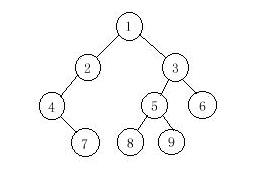HDOJ 1710 Binary Tree Traversals
Binary Tree Traversals
Time Limit: 1000/1000 MS (Java/Others) Memory Limit: 32768/32768 K (Java/Others)
Total Submission(s): 2019 Accepted Submission(s): 906
Problem Description
A binary tree is a finite set of vertices that is either empty or consists of a root r and two disjoint binary trees called the left and right subtrees. There are three most important ways in which the vertices of a binary tree can be systematically traversed or ordered. They are preorder, inorder and postorder. Let T be a binary tree with root r and subtrees T1,T2.
In a preorder traversal of the vertices of T, we visit the root r followed by visiting the vertices of T1 in preorder, then the vertices of T2 in preorder.
In an inorder traversal of the vertices of T, we visit the vertices of T1 in inorder, then the root r, followed by the vertices of T2 in inorder.
In a postorder traversal of the vertices of T, we visit the vertices of T1 in postorder, then the vertices of T2 in postorder and finally we visit r.
Now you are given the preorder sequence and inorder sequence of a certain binary tree. Try to find out its postorder sequence.

In a preorder traversal of the vertices of T, we visit the root r followed by visiting the vertices of T1 in preorder, then the vertices of T2 in preorder.
In an inorder traversal of the vertices of T, we visit the vertices of T1 in inorder, then the root r, followed by the vertices of T2 in inorder.
In a postorder traversal of the vertices of T, we visit the vertices of T1 in postorder, then the vertices of T2 in postorder and finally we visit r.
Now you are given the preorder sequence and inorder sequence of a certain binary tree. Try to find out its postorder sequence.

Input
The input contains several test cases. The first line of each test case contains a single integer n (1<=n<=1000), the number of vertices of the binary tree. Followed by two lines, respectively indicating the preorder sequence and inorder sequence. You can assume they are always correspond to a exclusive binary tree.
Output
For each test case print a single line specifying the corresponding postorder sequence.
Sample Input
9
1 2 4 7 3 5 8 9 6
4 7 2 1 8 5 9 3 6
Sample Output
7 4 2 8 9 5 6 3 1
Source
Recommend
lcy
二叉树的3种遍历,因为没看清是多样例输出,WA了很久很久。。。
很标准的做法是:先重建树,再按题目要求遍历树
1 #include <iostream> 2 #include <vector> 3 //#include <fstream> 4 5 6 using namespace std; 7 8 9 int pre[1100]; 10 int mid[1100]; 11 12 13 vector<int> v; 14 15 16 int n; 17 18 19 struct Note 20 { 21 int key; 22 int ch[2]; 23 }Tree[1100]; 24 25 26 int cur=0; 27 28 29 int build(int pb,int mb,int n) 30 { 31 int i,k; 32 if(n==0) return -1; 33 k=cur++; 34 Tree[k].key=pre[pb]; 35 for(i=0;i<n&&pre[pb]!=mid[mb+i];i++) ; 36 37 38 Tree[k].ch[0]=build(pb+1,mb,i); 39 Tree[k].ch[1]=build(pb+i+1,mb+i+1,n-1-i); 40 41 42 return k; 43 } 44 45 46 void print(int k,int l,int r) 47 { 48 if(l!=-1) 49 print(l,Tree[l].ch[0],Tree[l].ch[1]); 50 if(r!=-1) 51 print(r,Tree[r].ch[0],Tree[r].ch[1]); 52 53 54 v.push_back(Tree[k].key); 55 } 56 57 58 int main() 59 { 60 // ifstream fin; 61 // fin.open("ssf.txt"); 62 63 64 65 66 while(cin>>n) 67 { 68 cur=0; 69 for(int i=0;i<n;i++) 70 { 71 cin>>pre[i]; 72 } 73 for(int i=0;i<n;i++) 74 { 75 cin>>mid[i]; 76 } 77 78 79 build(0,0,n); 80 81 print(0,Tree[0].ch[0],Tree[0].ch[1]); 82 83 84 for(int u=0;u<n;u++) 85 { 86 if(u!=0) cout<<" "; 87 cout<<v.at(u); 88 } 89 cout<<endl; 90 91 while(!v.empty()) 92 v.pop_back(); 93 94 } 95 return 0; 96 }


